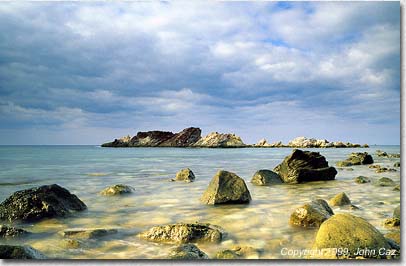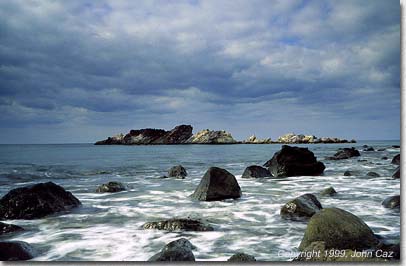
Photo Tip...
The Midas Touch
 The first image is the final result of my attempts at capturing what I previsualized. The second is what the seascape actually looked like without overexposing and without the golden rays shining on it. If you look closer you will notice that the cloud formations are nearly identical, meaning that you have to be ready for when the clouds open up and let the sun shine through. Those clouds were moving quite fast so you can imagine how difficult it is to capture such images. Nothing changes the appearance or mood of a landscape as profoundly as drastic changes in the weather. Storms are powerful sources of drama and excitement. Getting out there and capturing this drama can be as thrilling an experience as the storm itself.
The first image is the final result of my attempts at capturing what I previsualized. The second is what the seascape actually looked like without overexposing and without the golden rays shining on it. If you look closer you will notice that the cloud formations are nearly identical, meaning that you have to be ready for when the clouds open up and let the sun shine through. Those clouds were moving quite fast so you can imagine how difficult it is to capture such images. Nothing changes the appearance or mood of a landscape as profoundly as drastic changes in the weather. Storms are powerful sources of drama and excitement. Getting out there and capturing this drama can be as thrilling an experience as the storm itself.
For this particular shot, I remained in the wind and cold for quite some time. The tripod's legs were submerged in the saltwater and I was constantly trying to protect my camera from the splashing seawater. Although in this picture the overexposure and golden sunrays portray a slightly different mood than the one I actually experienced, it is the way I wanted to portray this winter landscape. I like the idea of trying to capture the moment of exchange between the “bright sunny day” and “stormy weather ahead” phenomenom. These are moments we rarely see because when they happen we are usually safely tucked indoors.
 In most of my winter landscapes, I try to capture the arrival of the storm in contrast with the sunlit landscape. I also stick with wide angle lenses for these shots, mainly because I feel the need to capture large portions of both sky and ground. In these conditions, with a little patience the sky can produce the most amazing and dramatic images, adding to the mood you're trying to convey in the image. When witnessing sunrays crossing the gray winter landscape, it is a magical moment that fills you with warmth and excitement. This is why I like to overexpose with these conditions to emphasize the suns presence.
In most of my winter landscapes, I try to capture the arrival of the storm in contrast with the sunlit landscape. I also stick with wide angle lenses for these shots, mainly because I feel the need to capture large portions of both sky and ground. In these conditions, with a little patience the sky can produce the most amazing and dramatic images, adding to the mood you're trying to convey in the image. When witnessing sunrays crossing the gray winter landscape, it is a magical moment that fills you with warmth and excitement. This is why I like to overexpose with these conditions to emphasize the suns presence.
The best times are usually on their approach or departure. It’s usually recommended that during a storm we protect ourselves by remaining indoors. Well that’s usually what happens, unless you don’t mind being assaulted by rain, wind, hail and lightning. So if you do remain outdoors, take extra care.
John Caz
Image technical data - Nikon F5, 20/2.8 Nikkor, Manfrotto Tripod and ballhead, Fuji Velvia, f/22 at 10 - 20 seconds, Cokin ND filter.
|

 The first image is the final result of my attempts at capturing what I previsualized. The second is what the seascape actually looked like without overexposing and without the golden rays shining on it. If you look closer you will notice that the cloud formations are nearly identical, meaning that you have to be ready for when the clouds open up and let the sun shine through. Those clouds were moving quite fast so you can imagine how difficult it is to capture such images. Nothing changes the appearance or mood of a landscape as profoundly as drastic changes in the weather. Storms are powerful sources of drama and excitement. Getting out there and capturing this drama can be as thrilling an experience as the storm itself.
The first image is the final result of my attempts at capturing what I previsualized. The second is what the seascape actually looked like without overexposing and without the golden rays shining on it. If you look closer you will notice that the cloud formations are nearly identical, meaning that you have to be ready for when the clouds open up and let the sun shine through. Those clouds were moving quite fast so you can imagine how difficult it is to capture such images. Nothing changes the appearance or mood of a landscape as profoundly as drastic changes in the weather. Storms are powerful sources of drama and excitement. Getting out there and capturing this drama can be as thrilling an experience as the storm itself. In most of my winter landscapes, I try to capture the arrival of the storm in contrast with the sunlit landscape. I also stick with wide angle lenses for these shots, mainly because I feel the need to capture large portions of both sky and ground. In these conditions, with a little patience the sky can produce the most amazing and dramatic images, adding to the mood you're trying to convey in the image. When witnessing sunrays crossing the gray winter landscape, it is a magical moment that fills you with warmth and excitement. This is why I like to overexpose with these conditions to emphasize the suns presence.
In most of my winter landscapes, I try to capture the arrival of the storm in contrast with the sunlit landscape. I also stick with wide angle lenses for these shots, mainly because I feel the need to capture large portions of both sky and ground. In these conditions, with a little patience the sky can produce the most amazing and dramatic images, adding to the mood you're trying to convey in the image. When witnessing sunrays crossing the gray winter landscape, it is a magical moment that fills you with warmth and excitement. This is why I like to overexpose with these conditions to emphasize the suns presence.